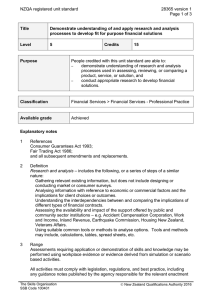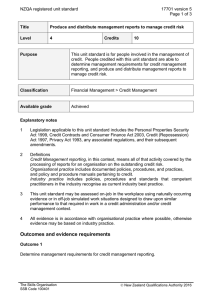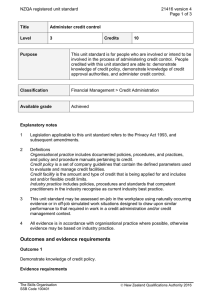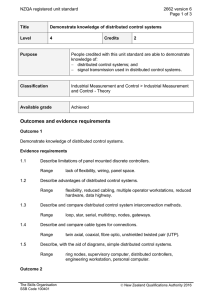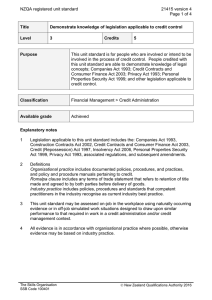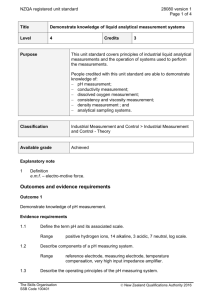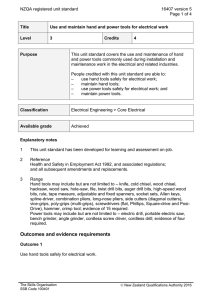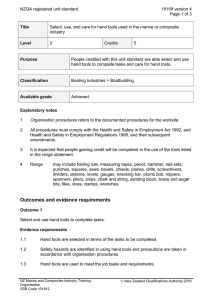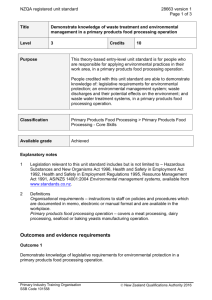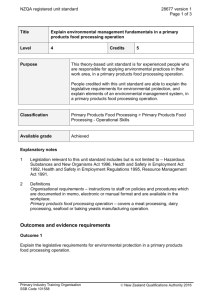70KB - NZQA
advertisement
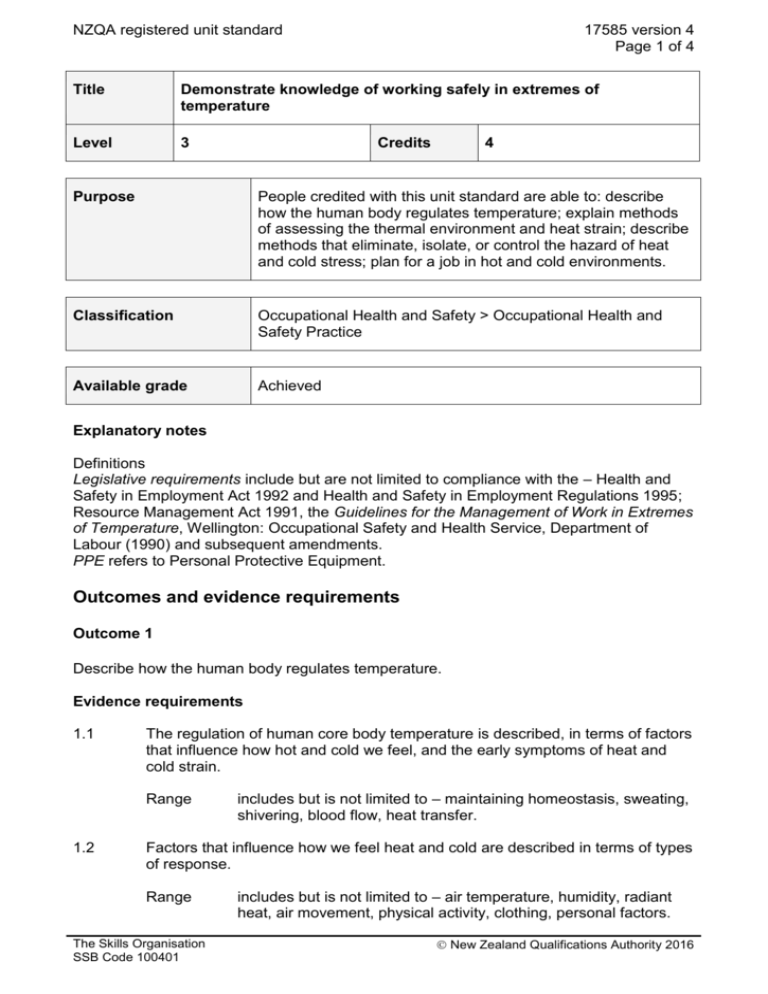
NZQA registered unit standard 17585 version 4 Page 1 of 4 Title Demonstrate knowledge of working safely in extremes of temperature Level 3 Credits 4 Purpose People credited with this unit standard are able to: describe how the human body regulates temperature; explain methods of assessing the thermal environment and heat strain; describe methods that eliminate, isolate, or control the hazard of heat and cold stress; plan for a job in hot and cold environments. Classification Occupational Health and Safety > Occupational Health and Safety Practice Available grade Achieved Explanatory notes Definitions Legislative requirements include but are not limited to compliance with the – Health and Safety in Employment Act 1992 and Health and Safety in Employment Regulations 1995; Resource Management Act 1991, the Guidelines for the Management of Work in Extremes of Temperature, Wellington: Occupational Safety and Health Service, Department of Labour (1990) and subsequent amendments. PPE refers to Personal Protective Equipment. Outcomes and evidence requirements Outcome 1 Describe how the human body regulates temperature. Evidence requirements 1.1 The regulation of human core body temperature is described, in terms of factors that influence how hot and cold we feel, and the early symptoms of heat and cold strain. Range 1.2 includes but is not limited to – maintaining homeostasis, sweating, shivering, blood flow, heat transfer. Factors that influence how we feel heat and cold are described in terms of types of response. Range The Skills Organisation SSB Code 100401 includes but is not limited to – air temperature, humidity, radiant heat, air movement, physical activity, clothing, personal factors. New Zealand Qualifications Authority 2016 NZQA registered unit standard 1.3 17585 version 4 Page 2 of 4 Potential health effects from exposure to extremes of temperature are explained in terms of mental and physical responses. Range effects include but are not limited to – muscle cramps, changes in breathing patterns, dizziness, severe headaches, dehydration, heat syncope, heat rashes, heat cramps, heat exhaustion, heat stroke, frostnip, frostbite, immersion foot, shivering, pain, numbness, drowsiness, loss of consciousness, death. Outcome 2 Explain methods of assessing the thermal environment and heat strain. Evidence requirements 2.1 The explanation establishes the purpose of the Wet Bulb Globe Temperature measures and how and when they should be used. Range 2.2 includes but is not limited to – air temperature, radiant heat, humidity, air speed. Methods of assessing heat strain are explained in terms of health and safety requirements. Range includes but is not limited to – core body temperature, ear monitors, heart rate. Outcome 3 Describe methods that eliminate, isolate, or control the hazard of heat and cold stress. Evidence requirements 3.1 Control measures for reducing the risk of heat and cold stress are described in terms of prevention and health and safety requirements. Range 3.2 Environmental controls for reducing the risk of heat and cold stress are described in terms of prevention and meeting health and safety requirements. Range 3.3 includes but is not limited to – eliminating or controlling the thermal source, work scheduling. includes but is not limited to – ventilation, controlling humidity, providing cooling, heating, shielding the work environment. Process and design controls for reducing the risk of heat and cold stress are described in terms of prevention, and meeting health and safety requirements. Range The Skills Organisation SSB Code 100401 includes but is not limited to – reduce/increase the heat required for the task or process, use of insulating materials. New Zealand Qualifications Authority 2016 NZQA registered unit standard 3.4 Administrative controls for reducing the risk of heat and cold stress are described in terms of prevention and meeting health and safety requirements. includes but is not limited to – minimise workers’ exposure times, work and rest schedules, planning work times for best temperatures, training, reduce physical load, suitable clothing, cooling PPE, acclimatisation, emergency support. Range 3.5 17585 version 4 Page 3 of 4 Medical controls for reducing the risk of heat and cold stress are described in terms of prevention and meeting health and safety requirements. includes but is not limited to – regular rehydration, maintain fitness, healthy eating, medical screening and assessments, monitoring, personal hygiene, health questionnaires. Range Outcome 4 Plan for a job in hot and cold environments. Evidence requirements 4.1 The plan describes procedures that will minimise the risks when working in hot and cold environments. includes but is not limited to – assessing the environment, verifying personal knowledge, monitoring personal health, equipment required, support systems. Range 4.2 The planned actions are consistent with health and safety requirements. 4.3 The planned actions are consistent with proposed activities in terms of people, responsibilities, resources and exposure in the environment. Range both hot and cold environments. Planned review date 31 December 2015 Status information and last date for assessment for superseded versions Process Version Date Last Date for Assessment Registration 1 14 December 2000 N/A Revision 2 16 May 2005 N/A Review 3 25 May 2007 N/A Rollover and Revision 4 22 May 2014 N/A Consent and Moderation Requirements (CMR) reference 0003 This CMR can be accessed at http://www.nzqa.govt.nz/framework/search/index.do. The Skills Organisation SSB Code 100401 New Zealand Qualifications Authority 2016 NZQA registered unit standard 17585 version 4 Page 4 of 4 Please note Providers must be granted consent to assess against standards (accredited) by NZQA, before they can report credits from assessment against unit standards, or deliver courses of study leading to that assessment. Industry Training Organisations must be granted consent to assess against standards by NZQA before they can register credits from assessment against unit standards. Providers and Industry Training Organisations, which have been granted consent and which are assessing against unit standards must engage with the moderation system that applies to those standards. Requirements for consent to assess and an outline of the moderation system that applies to this standard are outlined in the Consent and Moderation Requirements (CMR). The CMR also includes useful information about special requirements for organisations wishing to develop education and training programmes, such as minimum qualifications for tutors and assessors, and special resource requirements. Comments on this unit standard Please contact The Skills Organisation reviewcomments@skills.org.nz if you wish to suggest changes to the content of this unit standard. The Skills Organisation SSB Code 100401 New Zealand Qualifications Authority 2016
